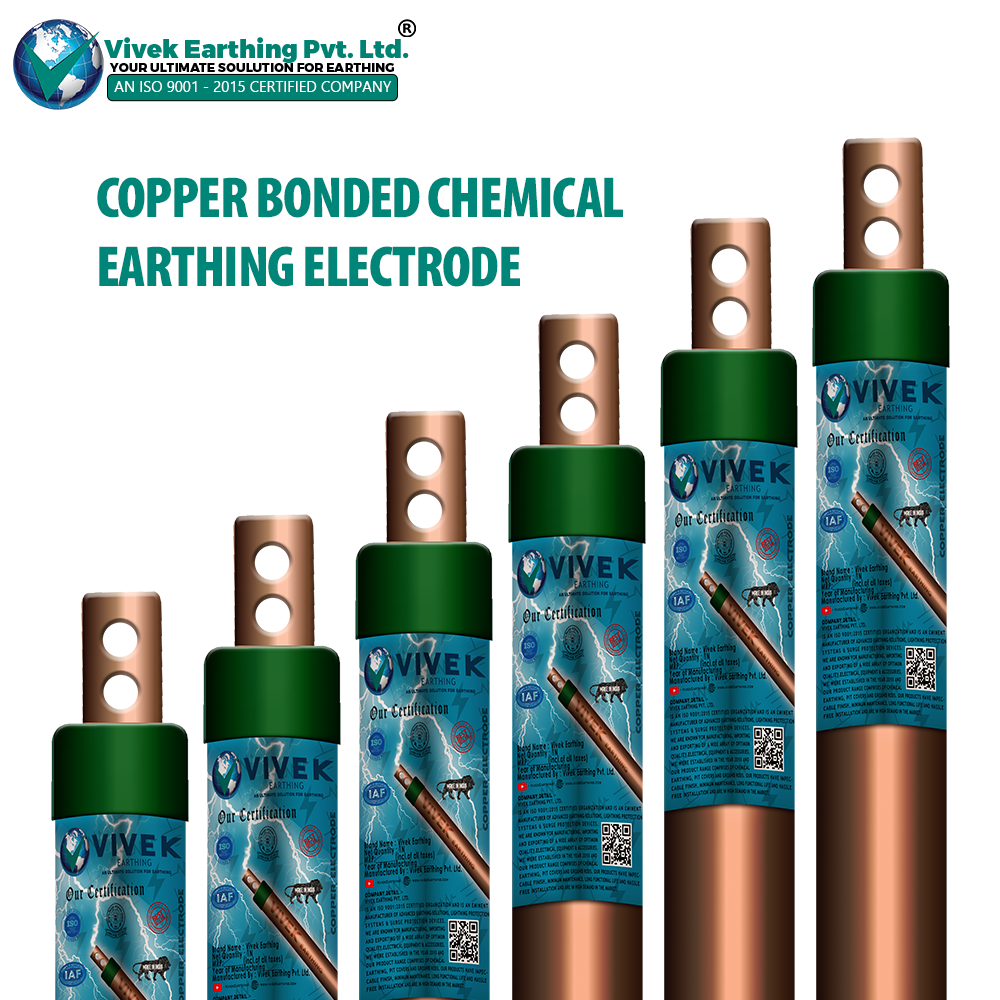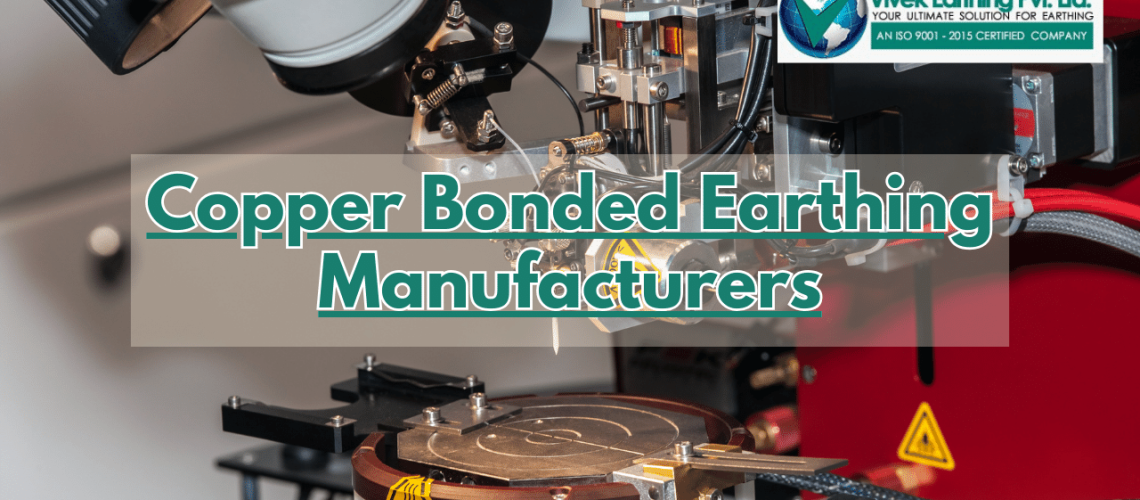Overview
In the realm of electrical safety, earthing or grounding plays a pivotal role. Among the various materials and methods used, copper bonded earthing stands out for its efficiency and reliability. This article delves into the world of copper bonded earthing, highlighting insights from leading copper bonded earthing manufacturers, including the renowned Vivek Earthing.

Understanding Copper Bonded Earthing
Copper bonded earthing involves the use of rods that are coated with copper, ensuring high conductivity and corrosion resistance. This method is preferred due to its durability and effectiveness in protecting against electrical surges and lightning strikes.
Why Choose Copper Bonded Earthing?
High Conductivity: Copper’s excellent conductivity ensures effective dissipation of fault currents.
Corrosion Resistance: The bonding process gives these rods a high corrosion resistance, extending their lifespan.
Cost-Effectiveness: Compared to pure copper rods, copper bonded rods offer similar benefits at a more economical price point.
Durability: These rods withstand extreme environmental conditions, making them a reliable choice for various applications.
The Role of Copper Bonded Earthing Manufacturers
Copper bonded earthing manufacturers play a crucial role in ensuring the quality and reliability of these grounding solutions. They employ advanced technologies and stringent quality control measures to produce earthing rods that meet international standards.
Leading the Way: Vivek Earthing
As a prime example, Vivek Earthing stands out among copper bonded earthing manufacturers. Their commitment to quality, innovation, and customer satisfaction has positioned them as a leader in this field.
Applications of Copper Bonded Earthing
Copper bonded earthing finds its applications in diverse sectors:
Residential and Commercial Buildings: For protecting structures and electrical systems from lightning and surges.
Industrial Setups: In factories and plants to safeguard machinery and reduce the risk of electrical hazards.
Telecommunication Towers: To ensure the smooth operation of communication systems.
Power Generation and Distribution: Critical in substations and power plants for safety and operational efficiency.
The Manufacturing Process
The process of manufacturing copper bonded earthing rods involves several key steps:
Selection of Core Material: Usually, high-grade steel is chosen for its strength.
Copper Bonding: The steel core is coated with a layer of copper, typically through electroplating or molecular bonding.
Quality Testing: Rigorous tests are conducted to ensure electrical conductivity, thickness of the copper layer, and corrosion resistance.
Compliance with Standards
Reputable copper bonded earthing manufacturers, like Vivek Earthing, adhere to international standards such as UL, IEC, or ANSI. Compliance ensures that the products are safe, reliable, and effective.
Installation and Maintenance
Proper installation and maintenance are crucial for the effectiveness of copper bonded earthing systems. Manufacturers often provide guidelines and may offer installation services.
Installation Considerations
Site Assessment: Evaluating soil type, moisture content, and other environmental factors.
Depth and Spacing: Determining the optimal depth and spacing of the rods for effective grounding.
Connection and Testing: Ensuring secure connections and testing the system for proper functionality.
Maintenance Tips
Regular Inspection: Checking for physical damage or corrosion.
Testing Ground Resistance: Periodic testing to ensure that the grounding system maintains its effectiveness.
Cleaning and Tightening Connections: Keeping connections clean and tight to prevent loss of conductivity.
Challenges and Innovations
Copper bonded earthing manufacturers face various challenges, such as fluctuating raw material prices and evolving regulatory standards. However, they continuously innovate to improve product quality and efficiency.
Innovations in the Field
Enhanced Bonding Techniques: Improving the bonding process for better durability and conductivity.
Eco-friendly Solutions: Developing environmentally sustainable manufacturing practices.
Customized Solutions: Offering tailor-made earthing solutions to meet specific requirements of different industries.
Choosing the Right Manufacturer
When selecting a copper bonded earthing manufacturer, consider the following:
Quality Certifications: Look for manufacturers with recognized quality certifications.
Industry Experience: Manufacturers with extensive experience are likely to offer more reliable products.
Customer Reviews and Testimonials: Feedback from previous customers can provide valuable insights.
After-Sales Support: Good after-sales support indicates a commitment to customer satisfaction.

Conclusion
Copper bonded earthing is a critical component in ensuring electrical safety across various sectors. Manufacturers like Vivek Earthing are at the forefront, offering high-quality, reliable, and innovative earthing solutions. By choosing the right manufacturer and adhering to proper installation and maintenance practices, one can significantly enhance the safety and efficiency of electrical systems.
In the dynamic field of electrical safety, copper bonded earthing manufacturers continue to play a vital role, evolving with technological advancements and regulatory changes to meet the growing demands of this critical industry.
FAQs
1. What are the latest advancements in copper bonded earthing technology?
Ans. Recent advancements in copper bonded earthing technology focuses on enhancing the durability and conductivity of earthing rods. Manufacturers are exploring improved bonding techniques that ensure a thicker and more uniform copper coating, leading to better corrosion resistance and longer lifespan. Additionally, there’s a trend towards eco-friendly manufacturing processes and the development of customized solutions to cater to specific industry needs.
2. How are copper bonded earthing manufacturers responding to environmental concerns?
Ans. Copper bonded earthing manufacturers are increasingly adopting environmentally sustainable practices. This includes using recycled materials where possible, minimizing waste during the manufacturing process, and implementing energy-efficient production methods. Some manufacturers are also researching and developing alternative materials and processes that have a lower environmental impact without compromising the quality and effectiveness of their products.
3. What should I look for in a copper bonded earthing manufacturer to ensure quality and reliability?
Ans. When selecting a copper bonded earthing manufacturer, look for certifications such as ISO, UL, or IEC, which indicate adherence to international quality standards. Additionally, consider the manufacturer’s experience in the industry, technological capabilities, and customer reviews. Manufacturers who offer comprehensive after-sales support, including installation guidance and maintenance services, are often more reliable.
4. Are there any innovative installation techniques being used by copper bonded earthing manufacturers?
Ans. Yes, some manufacturers are introducing innovative installation techniques that enhance the effectiveness and efficiency of earthing systems. These include advanced drilling methods for deeper and more secure rod placement, especially in challenging terrain. There’s also a trend towards using sophisticated grounding resistance measurement tools to ensure optimal installation. Furthermore, some manufacturers are offering modular and easy-to-install designs that reduce installation time and costs.
5. How is the rise of renewable energy sources impacting copper bonded earthing manufacturers?
Ans. The rise of renewable energy sources like solar and wind power is creating new opportunities and challenges for copper bonded earthing manufacturers. These energy systems require robust earthing for safety and efficiency, leading to increased demand for high-quality earthing solutions. Manufacturers are responding by developing specialized products tailored for renewable energy applications, focusing on durability to withstand environmental challenges and ensuring compatibility with the unique requirements of these systems.



2 Responses